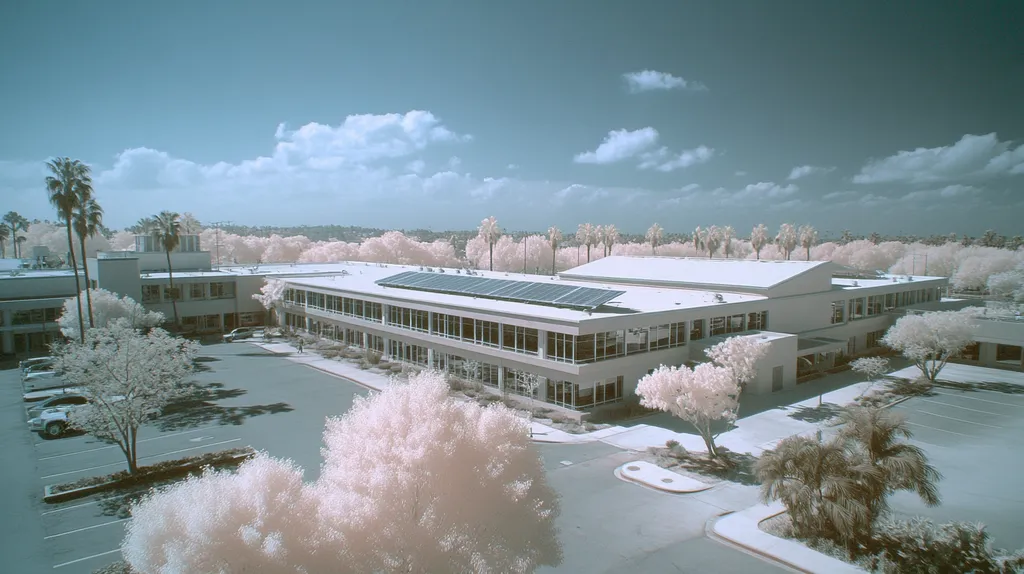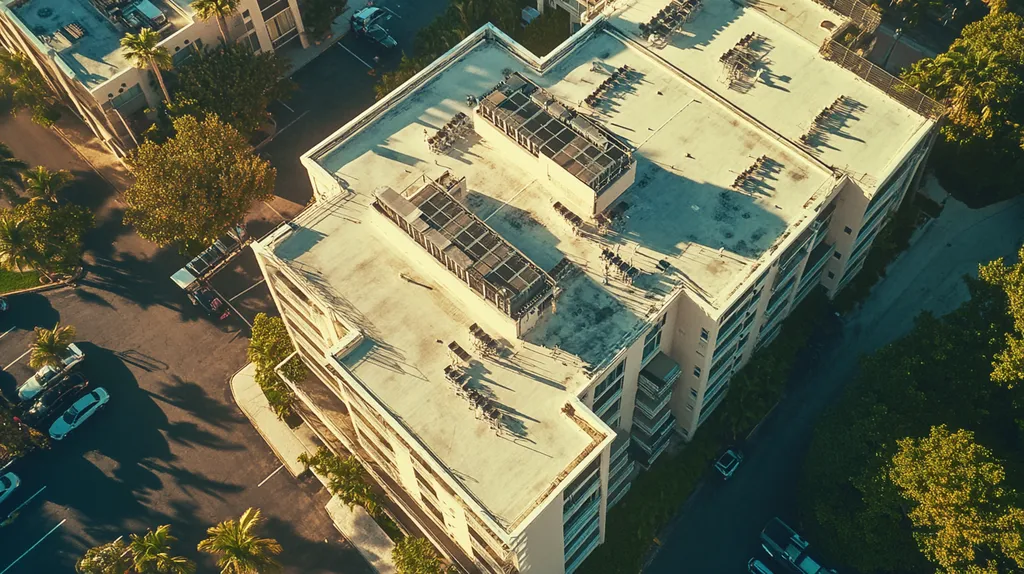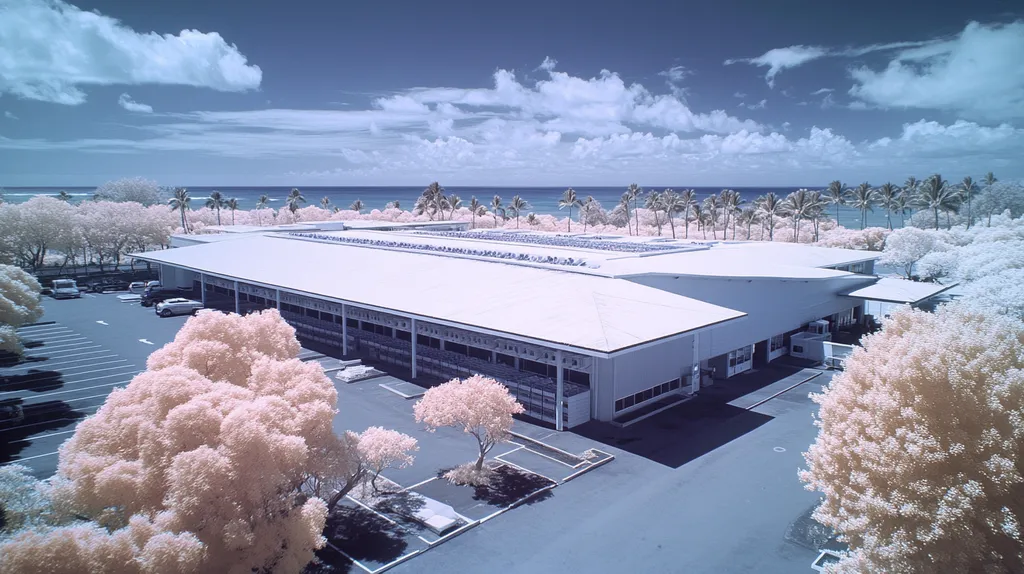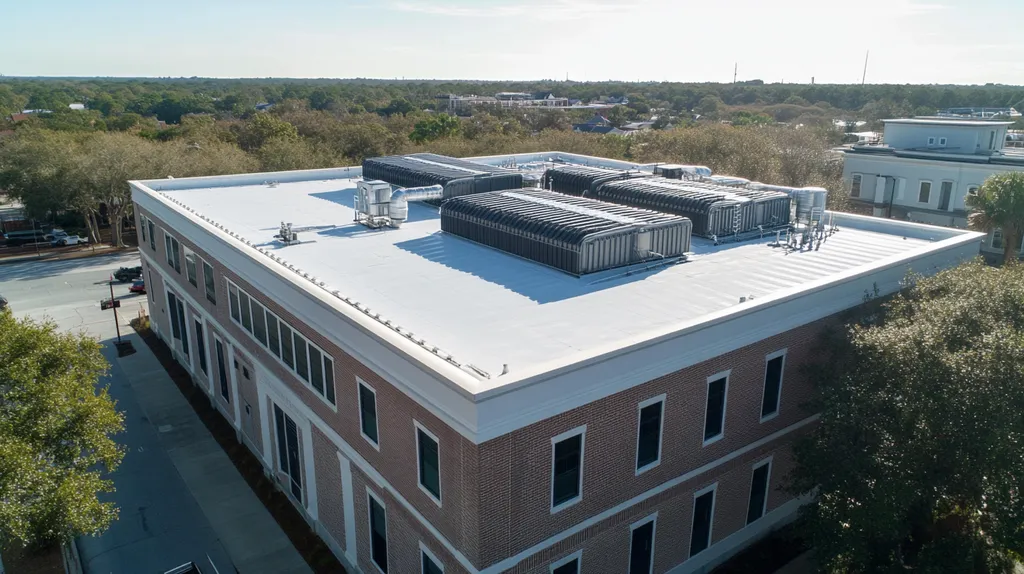Industrial roof coating failures cost commercial facilities over $400 million annually in repairs and operational disruptions, with improper application accounting for 70% of premature system breakdowns. As building material costs continue rising 8-12% each year, effective contractor training has become critical for protecting these vital assets.
Modern coating technologies offer unprecedented opportunities for extending roof life while reducing energy costs, but only when applied correctly. This comprehensive guide examines the essential components of contractor training programs, from fundamental coating chemistry through advanced application techniques.
Through systematic instruction in proper material selection, surface preparation, and quality control protocols, facilities can dramatically reduce failure rates while maximizing their return on coating investments.
SECTION 1: FUNDAMENTAL CONCEPTS
Industrial roof coating systems represent a critical investment for commercial properties, with improper selection or application leading to premature failures that can cost facilities millions in repairs. As building materials costs continue rising by 8-12% annually, the stakes for getting coating decisions right have never been higher. Understanding the fundamentals of industrial roof coatings enables property owners to maximize protection while optimizing their maintenance budgets.
Types of Industrial Roof Coatings
The three primary commercial roof coating categories – acrylic, silicone, and polyurethane – each serve distinct purposes based on environmental conditions and substrate requirements. Acrylic coatings offer excellent UV protection and color stability while providing a cost-effective water-based solution for many roof types.
Silicone coatings deliver superior waterproofing capabilities and maintain flexibility across extreme temperature variations, making them ideal for challenging climates and ponding water conditions. Their moisture-cured chemistry allows for application even in high-humidity environments.
Polyurethane systems provide exceptional durability and chemical resistance, particularly suited for manufacturing facilities exposed to harsh conditions. Their multi-layer application creates a robust protective barrier that resists physical damage and environmental stress.
The selection process must account for factors including local climate, roof substrate condition, and specific facility requirements to ensure optimal performance. (source: SmartSeal)
Benefits and Advantages of Roof Coatings
Industrial roof coatings deliver substantial returns through multiple value streams, starting with asset preservation. A properly specified and applied coating system can extend roof service life by 10-15 years, deferring costly replacement projects.
Energy efficiency represents another major benefit, with reflective coatings reducing cooling loads by up to 35% in warm climates. This translates to immediate operational cost savings while supporting corporate sustainability goals.
Waterproofing capabilities prevent moisture infiltration that can damage expensive equipment and disrupt operations. Modern coating systems create seamless membranes that eliminate vulnerable seams and penetrations.
The non-destructive nature of coating applications allows facilities to maintain operations during installation, avoiding costly shutdowns. This minimal disruption approach preserves both productivity and profitability.
Common Roof Coating Chemistries
Understanding coating chemistry fundamentals enables proper material selection and application procedures. Elastomeric formulations provide essential flexibility, expanding and contracting with the substrate to maintain protection through thermal cycling.
Cross-linking chemistry in high-performance coatings creates strong molecular bonds that resist degradation from UV exposure and chemical attack. This enhanced durability translates directly to extended service life.
Moisture-cured systems leverage atmospheric humidity to trigger the curing process, while two-component formulations require precise mixing ratios to achieve proper molecular structure. Each chemistry type demands specific environmental conditions for optimal curing.
Advanced polymer technologies enable customized solutions targeting specific performance requirements. Understanding these molecular-level interactions helps predict long-term coating behavior and durability.
SECTION 2: SYSTEM COMPONENTS
Industrial roof coating systems represent a complex interplay of materials that must work in harmony to protect valuable assets. Recent industry data shows that system component failures account for over 60% of premature roof coating breakdowns, resulting in millions in repair costs annually. Understanding these critical components and their interactions has become even more vital as extreme weather events increase in frequency and intensity.
Roof Substrates and Compatibility
The substrate forms the foundation of any successful roof coating system. Common industrial substrates include modified bitumen, single-ply membranes, metal panels, and concrete decking, each demanding specific preparation and coating compatibility considerations.
Surface preparation requirements vary dramatically between substrates. Metal roofs require rust removal and proper primers, while single-ply membranes need specialized cleaning to remove accumulated environmental deposits that can impair adhesion.
Substrate condition assessment must include both visual inspection and adhesion testing. Even seemingly minor surface contamination can prevent proper coating bond formation, leading to premature system failure.
Temperature fluctuations affect different substrates uniquely. Metal expands and contracts significantly more than other materials, requiring coatings with superior flexibility and adhesion properties to maintain protection through thermal cycling.
Coating Materials and Formulations
Modern industrial roof coatings utilize advanced polymer technologies to deliver specific performance characteristics. Each formulation offers unique advantages in terms of weathering, chemical resistance, and application properties.
Acrylic coatings provide excellent UV protection and color stability while offering a cost-effective water-based solution for many roof types. Silicone coatings excel in extreme temperature variations and ponding water conditions, while polyurethane systems deliver superior durability and chemical resistance. (source: SmartSeal)
Film thickness requirements vary by coating type and exposure conditions. Under-application compromises protection while over-application wastes material and can lead to curing defects.
Environmental conditions during application significantly impact coating performance. Temperature, humidity, and dew point must all fall within specified ranges to achieve proper film formation and cure.
Adhesives and Primers
Primers serve as the critical link between substrate and coating, promoting adhesion and preventing coating failure. Proper primer selection depends on both substrate type and final coating chemistry.
Application timing between primer and topcoat layers requires careful coordination. Missing the recoat window can necessitate additional surface preparation and significantly increase project costs.
Different primers offer varying levels of corrosion protection and moisture resistance. Projects in coastal environments or areas with high industrial emissions require enhanced protective properties.
Modern water-based primers have largely replaced traditional solvent-based products, offering improved safety and environmental compliance while maintaining excellent adhesion properties.
SECTION 3: IMPLEMENTATION METHODS
Successful industrial roof coating projects demand meticulous attention to implementation methods and techniques. Recent studies show that over 70% of coating failures stem from improper application procedures rather than material defects. With material costs continuing to rise, the financial impact of application errors has never been higher – a single failed coating project on a 50,000 square foot roof can result in hundreds of thousands in remediation expenses.
Surface Preparation and Inspection
Thorough surface preparation forms the foundation of every successful coating project. Initial inspections must identify and document all existing damage, moisture intrusion points, and structural concerns before any work begins.
Power washing alone is insufficient – surfaces require mechanical cleaning to achieve proper adhesion profiles. This includes addressing rust, scale, and previous coating residues that can compromise the new system’s performance.
Moisture testing using both electronic meters and core samples helps identify trapped water that could cause premature coating failure. Areas showing elevated moisture levels require targeted drying or replacement before coating application can proceed.
Special attention must focus on seams, penetrations, and transitions where movement stress concentrates. These areas typically require reinforcement and additional preparation steps to ensure long-term performance.
Application Techniques: Spraying, Rolling, Brushing
Each application method serves specific purposes in a comprehensive coating strategy. Spray application enables rapid coverage of large open areas while maintaining consistent mil thickness across the surface.
Rolling provides superior control around obstacles and ensures proper material penetration into substrate texture. This technique proves especially valuable on rough or irregular surfaces where spray application might leave voids.
Brush application delivers the highest level of control for detail work and critical transitions. Small brushes allow coating material to be worked into tight corners and seams where other methods might provide inadequate coverage.
For optimal results, contractors must master multiple application techniques and understand when to employ each method. Proper training enables teams to seamlessly transition between approaches as surface conditions and project requirements dictate. (source: Coatings Coffee Shop)
Equipment Selection and Usage
Professional-grade application equipment represents a critical investment in coating success. High-pressure sprayers must deliver consistent atomization across varying coating viscosities while maintaining specified application rates.
Equipment maintenance directly impacts coating quality and project efficiency. Daily cleaning protocols prevent material cross-contamination and ensure reliable performance throughout the project timeline.
Modern coating equipment incorporates digital monitoring systems that track application parameters in real-time. These systems help maintain consistent coverage rates while documenting compliance with manufacturer specifications.
Safety equipment deserves equal attention, from proper respirators to fall protection systems. Well-maintained safety gear protects workers while enabling them to focus on precise application techniques.
SECTION 4: MAINTENANCE REQUIREMENTS
Industrial roof coating maintenance represents a critical investment protection strategy, with data showing that neglected systems fail 3-4 times faster than properly maintained ones. The financial impact is staggering – a single catastrophic roof failure can cost facilities over $1 million in equipment damage and operational disruptions. Yet studies indicate that 65% of commercial properties lack comprehensive maintenance programs, creating significant exposure to preventable risks.
Regular Inspection and Repair
Systematic inspection protocols form the cornerstone of effective coating maintenance. Critical evaluations must occur at minimum twice annually, with additional assessments following severe weather events or nearby construction activities that could impact roof integrity.
Inspection scope must include detailed examination of high-stress areas including flashings, penetrations, and drainage points. These zones typically show the first signs of coating degradation and require swift intervention to prevent system-wide failures.
Documentation plays a vital role in tracking coating performance over time. Detailed reports should capture millage measurements, adhesion test results, and photographic evidence of any deterioration to enable data-driven maintenance decisions.
Early intervention with qualified repairs dramatically reduces lifetime maintenance costs. Even minor coating breaches can allow moisture infiltration that undermines the entire system, making rapid response protocols essential.
Cleaning and Protective Measures
The Roof Coatings Manufacturers Association emphasizes that proper surface cleaning and maintenance protocols significantly extend coating lifespans. Their training modules detail specific cleaning techniques and maintenance schedules tailored to different coating chemistries and environmental conditions. (source: Roof Coatings Manufacturers Association)
Debris removal must occur quarterly at minimum, with more frequent cleaning in areas with heavy foliage or industrial fallout. Accumulated organic matter traps moisture against the coating surface, accelerating degradation through prolonged wet contact.
Chemical cleaning agents require careful selection based on coating compatibility. Harsh cleaners can etch or degrade coating surfaces, while insufficient cleaning leaves contaminants that compromise coating adhesion and performance.
Walkway systems and protective barriers around mechanical equipment prevent coating damage from maintenance traffic. These sacrificial wear layers preserve coating integrity in high-traffic zones while clearly defining approved access routes.
Reapplication and Renewal
Coating reapplication timing depends on multiple factors including environmental exposure, substrate condition, and facility operations. Performance monitoring through regular testing helps identify optimal renewal windows before significant degradation occurs.
Surface preparation requirements for recoating often exceed those of initial application. Accumulated contaminants and coating oxidation demand aggressive cleaning and profiling to ensure proper adhesion of renewal coats.
Modern high-build coating systems can often be renewed through single-coat applications when existing systems remain fundamentally sound. This approach reduces labor costs while maintaining continuous protection.
Strategic timing of renewal projects allows facilities to leverage seasonal conditions for optimal application and curing. Careful planning prevents weather-related delays while maximizing coating performance potential.
SECTION 5: PERFORMANCE METRICS
Industrial roof coating performance metrics have become increasingly critical as energy costs continue rising 15-20% annually across commercial sectors. Yet studies reveal that over 70% of facility managers lack standardized methods for evaluating coating effectiveness, leading to premature failures and wasted investment. With proper metrics and monitoring, facilities can extend coating life by 40% while reducing energy costs by up to $0.75 per square foot annually.
Energy Efficiency and Cost Savings
Modern roof coatings can reduce peak roof surface temperatures by up to 80°F compared to uncoated substrates. This dramatic temperature reduction directly impacts HVAC loads, particularly during summer cooling seasons when energy demands peak.
Cool roof coatings with high solar reflectance indices (SRI) deliver measurable returns through reduced air conditioning costs. Studies show properly selected reflective coatings can lower cooling energy consumption by 25-35% in single-story buildings.
Thermal imaging and energy monitoring systems provide quantifiable data on coating performance. Regular infrared surveys can identify areas of heat infiltration while tracking overall system efficiency.
Many utilities and municipalities now offer incentive programs for energy-efficient roof coatings. These rebates can offset 15-30% of project costs while accelerating return on investment timelines.
Durability and Lifespan Evaluation
The Roof Coatings Manufacturers Association emphasizes comprehensive performance evaluation through standardized testing protocols that measure adhesion strength, flexibility, and weather resistance across coating systems. (source: Roof Coatings Manufacturers Association)
Adhesion testing must occur at regular intervals throughout the coating lifecycle. Pull-off strength measurements provide early warning of potential delamination while verifying long-term performance.
Weather resistance metrics track coating degradation from UV exposure, thermal cycling, and precipitation. Modern coatings should maintain 90% of their initial properties after 10 years of service.
Physical testing includes impact resistance, tensile strength, and elongation capabilities. These measurements help predict coating response to building movement and mechanical stress.
Compliance with Building Codes
Building codes increasingly mandate specific performance requirements for industrial roof coatings. Current standards focus on fire resistance, wind uplift resistance, and energy efficiency metrics that coatings must achieve.
Documentation requirements have expanded to include detailed performance test results. Maintaining comprehensive records protects facilities while demonstrating ongoing code compliance.
Many jurisdictions now require third-party verification of coating performance claims. Independent testing laboratories provide certified results that validate manufacturer specifications.
Code officials are implementing more frequent inspection requirements for coated roof assemblies. These assessments verify continued compliance while identifying maintenance needs before serious issues develop.
SECTION 6: OPTIMIZATION STRATEGIES
Industrial roof coating optimization has become increasingly critical as material costs surge 15-20% annually and weather patterns grow more extreme. Recent industry analysis shows that improper optimization strategies lead to 40% of coating failures within the first two years of installation, resulting in millions in preventable repairs. By implementing strategic approaches to climate considerations, labor efficiency, and emerging technologies, facilities can extend coating life by up to 75% while reducing application costs by 30%.
Climate and Environmental Considerations
Local climate conditions fundamentally impact coating performance and durability. Temperature swings, humidity levels, and precipitation patterns all affect cure times and adhesion properties, making regional climate adaptation essential for long-term success.
Seasonal timing proves critical for optimal application conditions. Projects scheduled during moderate temperature periods typically achieve 25-35% better adhesion compared to those applied during temperature extremes.
Dew point calculations must guide daily start times to prevent moisture-related failures. Morning condensation can reduce coating adhesion by up to 50% if proper environmental monitoring protocols aren’t followed.
Wind conditions require careful management during application. Spray patterns should be adjusted based on wind speed and direction to maintain consistent millage and prevent overspray damage.
Labor-Saving Techniques and Best Practices
The Roof Coatings Manufacturers Association provides comprehensive training modules covering surface evaluation, coating technologies, and application best practices that help contractors optimize their operations while maintaining quality standards. (source: Roof Coatings Manufacturers Association)
Strategic equipment positioning and material staging can reduce worker movement by up to 40%. Carefully planned layouts ensure efficient access to tools and supplies while minimizing trips across completed sections.
Team-based application approaches increase productivity by 25-30% compared to individual worker methods. Coordinated crews maintain wet edges more effectively while reducing application variables.
Quality control checkpoints integrated throughout the application process prevent costly rework. Regular thickness measurements and visual inspections catch issues before they impact large areas.
Integrating New Technologies and Products
Digital monitoring systems now enable real-time tracking of application conditions and coating performance. These tools provide instant feedback on temperature, humidity, and material consumption while documenting compliance with manufacturer specifications.
Advanced spray equipment incorporating GPS mapping ensures consistent coverage across large roof areas. Digital rate controllers maintain proper material application regardless of applicator speed or position.
Drone technology streamlines inspection processes while improving documentation quality. High-resolution imaging captures detailed surface conditions and identifies potential problem areas before they develop into failures.
Mobile applications now integrate project management, quality control, and documentation functions. Cloud-based platforms enable real-time collaboration between field teams and supervisory staff while maintaining comprehensive project records.
Moving Forward
With industrial roof coating failures costing facilities over $400 million annually, comprehensive contractor training has become mission-critical for protecting commercial assets.
The rapidly evolving coating technology landscape demands systematic instruction in material science, application techniques, and quality control to achieve optimal results.
Modern digital monitoring systems, drone inspections, and cloud-based documentation platforms are transforming how contractors apply and verify coating performance.
By implementing rigorous training programs focused on proper material selection, surface preparation, and application methods, facilities can reduce failure rates by up to 70% while extending coating lifespans by 40-50%.
The future of industrial roof coatings depends on contractors embracing both proven fundamentals and emerging technologies through structured, ongoing education.
FREQUENTLY ASKED QUESTIONS
Q. What are key concepts of industrial roof coatings?
A. Industrial roof coatings are essential for asset protection. Choosing the right system prevents costly failures that can arise from improper application, especially as construction material prices rise. Understanding coating types such as acrylic, silicone, and polyurethane helps property owners maximize durability and reduce long-term maintenance costs.
Q. How do roof substrates affect industrial roof coatings?
A. Substrates, like metal or concrete, are crucial for coating adhesion and performance. Proper surface preparation is essential to ensure compatibility with coating materials. Issues such as rust and contamination can lead to premature failures if not addressed before coating application.
Q. What are best practices for applying industrial roof coatings?
A. Successful application hinges on proper surface preparation and technique. Inspecting for damage and cleaning for adhesion are vital steps. Various methods like spraying, rolling, and brushing ensure thorough coverage and performance. Training contractors on these practices can significantly reduce errors and enhance outcomes.
Q. How important is maintenance for industrial roof coatings?
A. Regular maintenance is critical to extend roof coating life and prevent failures. Inspections should be conducted twice a year and after severe weather. Regular cleaning, immediate repairs, and thorough documentation help catch potential issues early, protecting investments and ensuring long-term performance.
Q. How can performance metrics improve industrial roof coating effectiveness?
A. Implementing effective performance metrics allows facility managers to track coating efficiency and longevity. Using metrics for energy savings and durability helps identify when coatings need maintenance or reapplication. Proper tracking enhances the lifespan of coatings by providing actionable insights for timely interventions.
Q. What optimization strategies can enhance industrial roof coatings?
A. Optimizing coating strategies involves considering local climate, labor efficiency, and emerging technologies. Scheduling applications during ideal weather ensures better adhesion, while modern equipment improves coverage. Utilizing comprehensive training can empower contractors to adopt best practices that extend coating lifespans and reduce costs.
Q. Why should contractors receive training for coating application?
A. Training equips contractors with essential skills to apply coatings correctly and efficiently. It reduces application errors that can lead to costly failures. Understanding different coating materials, application techniques, and maintenance requirements helps ensure that contractors deliver quality work, boosting overall system performance.











